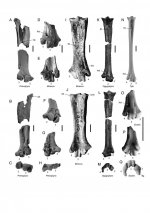albertonykus
Well-known member
Mayr, G., P.D. Gingerich, and T. Smith (2020)
Skeleton of a new owl from the early Eocene of North America (Aves, Strigiformes) with an accipitrid-like foot morphology
Journal of Vertebrate Paleontology (advance online publication)
doi: 10.1080/02724634.2020.1769116
https://www.tandfonline.com/doi/full/10.1080/02724634.2020.1769116
We describe a partial skeleton of a large-sized owl from Wasatchian strata of the Willwood Formation (Wyoming, U.S.A.). The holotype of Primoptynx poliotauros, gen. et sp. nov., includes all major postcranial bones and is one of the most substantial Paleogene records of the Strigiformes. The fossil shows that owls exhibited a considerable morphological diversity in the early Eocene of North America and occupied disparate ecological niches. As in the protostrigid taxon Minerva from the late early to early middle Eocene of North America, but unlike in extant owls, the ungual phalanges of the hallux and the second toe of the new species are distinctly larger than those of the other toes. Primoptynx poliotauros gen. et sp. nov., however, does not exhibit the derived tibiotarsus morphology of the Protostrigidae. Even though the new species may well be a stem group representative of protostrigid owls, current data do not allow an unambiguous phylogenetic placement. Concerning the size of the ungual phalanges, the feet of P. poliotauros correspond to those of extant hawks and allies (Accipitridae). We therefore hypothesize that it used its feet to dispatch prey items in a hawk-like manner, whereas extant owls kill prey with their beak. Primoptynx and protostrigid owls were possibly specialized in foraging on prey items that required an accipitrid-like killing strategy, such as larger-sized or more defensive mammals. The extinction of these peculiar owls may have been related to the radiation of accipitrid diurnal birds of prey, which appear to have diversified in the late Eocene and early Oligocene.
Skeleton of a new owl from the early Eocene of North America (Aves, Strigiformes) with an accipitrid-like foot morphology
Journal of Vertebrate Paleontology (advance online publication)
doi: 10.1080/02724634.2020.1769116
https://www.tandfonline.com/doi/full/10.1080/02724634.2020.1769116
We describe a partial skeleton of a large-sized owl from Wasatchian strata of the Willwood Formation (Wyoming, U.S.A.). The holotype of Primoptynx poliotauros, gen. et sp. nov., includes all major postcranial bones and is one of the most substantial Paleogene records of the Strigiformes. The fossil shows that owls exhibited a considerable morphological diversity in the early Eocene of North America and occupied disparate ecological niches. As in the protostrigid taxon Minerva from the late early to early middle Eocene of North America, but unlike in extant owls, the ungual phalanges of the hallux and the second toe of the new species are distinctly larger than those of the other toes. Primoptynx poliotauros gen. et sp. nov., however, does not exhibit the derived tibiotarsus morphology of the Protostrigidae. Even though the new species may well be a stem group representative of protostrigid owls, current data do not allow an unambiguous phylogenetic placement. Concerning the size of the ungual phalanges, the feet of P. poliotauros correspond to those of extant hawks and allies (Accipitridae). We therefore hypothesize that it used its feet to dispatch prey items in a hawk-like manner, whereas extant owls kill prey with their beak. Primoptynx and protostrigid owls were possibly specialized in foraging on prey items that required an accipitrid-like killing strategy, such as larger-sized or more defensive mammals. The extinction of these peculiar owls may have been related to the radiation of accipitrid diurnal birds of prey, which appear to have diversified in the late Eocene and early Oligocene.





